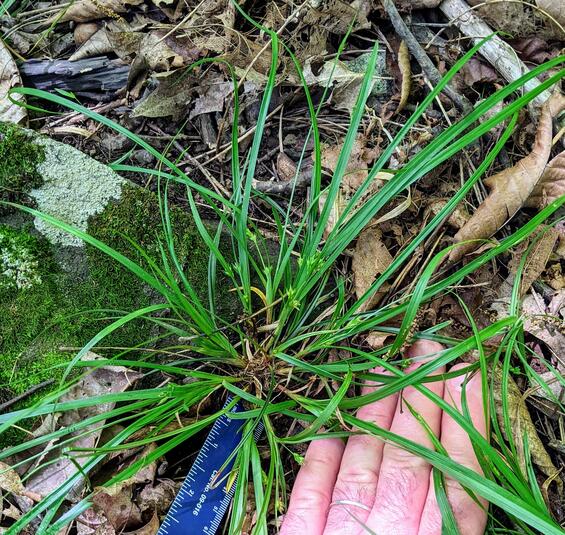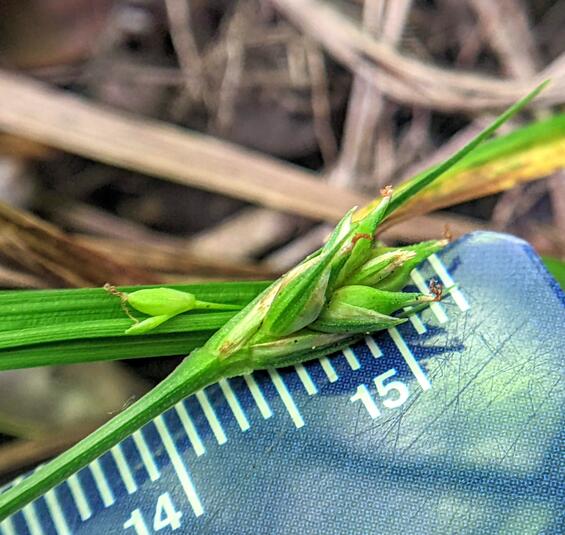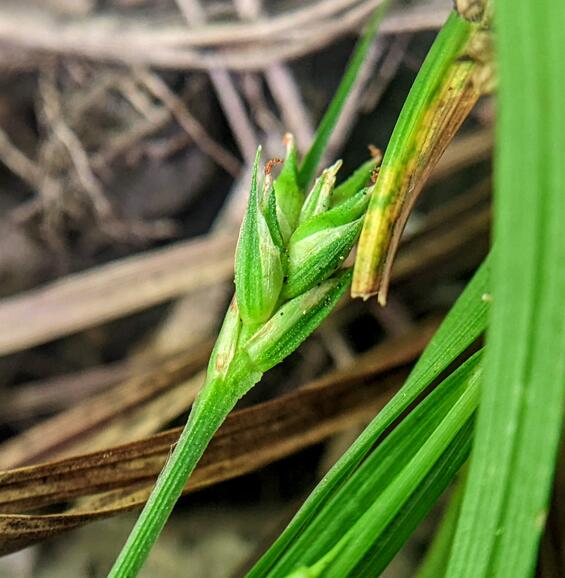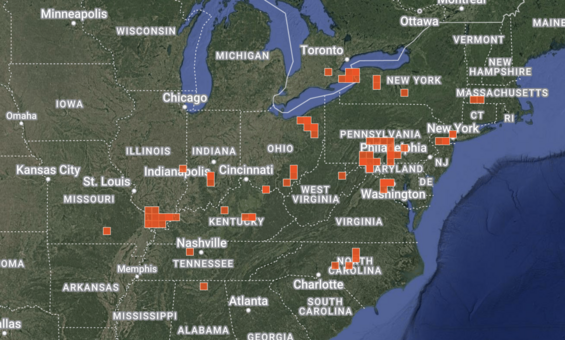- Scientific name: Carex willdenowii Schkuhr ex Willd.
- Species of Greatest Conservation Need (MA State Wildlife Action Plan)
- Endangered (MA Endangered Species Act)
Description

Willdenow’s sedge
Willdenow’s sedge is a grass-like plant in the genus Carex in the sedge family (Cyperaceae). Carex is the most species-rich genus in Massachusetts, with 180 taxa throughout the northeastern states (Bennett 1996, Cullina et al. 2011). Technical skills and a detailed dichotomous key are needed for proper identification of this group of plants.
The plant grows in dense short clumps on the forest floor. The fruiting stems are upright or spreading between 8.2-29.7 cm (3.2-11.7 in) in height. The green leaf blades can be a little longer than the stems, and are 1.3-3.2 mm (0.05-0.13 in) wide, and smooth to slightly scabrous. The flowers are born on both terminal and lateral spikes with the terminal including the staminate flowers. The pistillate portion has between 3 and 9 flowers. The pistillate scales are green with broad whitish, translucent margins. The scales are up to 2.22 mm (0.09 in) wide, not concealing the perigynia. The scale apex is attenuate into green awns. The perigynia are pale green to olive or pale brown, narrowly ovoid to lance-ovoid in shape and up to 6 mm in length × 1.7 mm wide (0.24 × 0 .07 in), with a tapered apex beak between1.9-2.6 mm (0.07-0.1 in) in length and scabrous. The achenes are brown, oblong and up to 2.5 mm (0.1 in) in length (Crins et al. 2020).

Pistillate spike of Carex willdenowii showing pistillate scales and perigynia.

Life cycle and behavior
Herbaceous perennial.
Population status
Willdenow's sedge was recently re-discovered in Massachusetts in the western part of the state. Three populations have been observed in the last 2 years. Prior to that, it hadn't been collected or reported, since the 1890s. It had not been observed and collected in western Massachusetts where it has been observed recently (Frost 2023). Collections have occurred in Hampden, Hampshire, Middlesex and Norfolk counties (Consortium of Northeastern Herbaria 2025).

Distribution in Massachusetts
1999-2024
Based on records in the Natural Heritage Database
Distribution and abundance
The center of the species distribution is the Appalachian Mountains and Piedmont (Kartesz, J.T. 2015). Weakley (2020) describes the distribution as from Massachusetts, Vermont (where it is state-historic), New York (where it is ranked S4, apparently secure), and southern Ontario (S1, critically imperiled), south to central Indiana, northcentral South Carolina (S1), and Alabama. Massachusetts currently represents the northeastern extent of the species.
In New England, herbarium records indicate collections from Connecticut, Maine, Massachusetts and Vermont. All the records are from the 19th century, except for three recent collections in Connecticut in 2003, 2006 and 2007 (CNH 2023). In addition, there is a fourth known population in Connecticut, first observed in 2018. (Frost 2023).

Map of research-grade observations of Carex willdenowii in North America screen-captured from iNaturalist.org on 24 March 2025.
Habitat
Its habitat is described variously as dry-mesic open oak woodlands, on rocky slopes or ridge lines with two occurrences in hickory hop-hornbeam natural community. Associated species included Carex pensylvanica (Pennsylvania sedge), Carex radiata (star-sedge), Carex rosea (big star-sedge), Carya glabra (pignut hickory), Crataegus spp. (hawthorn), Dichanthelium dichotomum ssp. dichotomum (forked panic-grass), Ostrya virginiana (hop-hornbeam), Swida racemosa (gray dogwood), Symphyotrichum undulatum (wavy-leaved aster), and Trichophorum planifolium (woodland bulrush).
Healthy habitats are vital for supporting native wildlife and plants. Explore habitats and learn about conservation and restoration in Massachusetts.
Threats
The primary threats to this species appear to be invasive species such as swallowwort (Cynanchum, two species) and garlic mustard, and deer herbivory. One site where this species occurs shows evidence of extreme deer browse. Members of the genus Carex are almost all cool season plants that green up early in the spring making them attractive targets for deer to consume when food resources are scarce. Clumps of sedges chewed off by deer are often readily visible in the spring on some sites.
Conservation
Survey and monitoring
Given these are likely relatively long-lived perennial species, monitoring could be done on a five-year cycle in the fall with estimates of plant vigor and seed production.
Management
Control of invasive species and excess deer numbers are both appropriate targets for management. In addition, it is likely these slopes had a natural fire return interval of a decade or two, so prescribed fire should be considered as a management tool.
Research needs
Research is needed to determine seed viability, optimal seed collection time, and seed germination techniques to see whether this plant can be grown in a nursery or garden setting for purposes of reintroductions. With so few populations of this species, the loss of even one population could have serious effects. Therefore, a reintroduction strategy could prove useful to long-term conservation of this species.
References
Bennett, J. P. 1996. Floristic summary of Manual of Vascular Plants of Northeastern United States and Adjacent Canada, second edition. The Botanical Review 62: 203–206.
CNH 2023 Herbarium specimen data provided by: NEBC Herbarium, The Gray Herbarium (both at the Harvard University Herbaria), Pringle Herbarium, University of Vermont, and William and Lynda Steere Herbarium, New York Botanical Garden (Accessed through the Consortium of Northeastern Herbaria web site, www.neherbaria.org, 2023-02-10)
Consortium of Northeastern Herbaria. 2025. Herbarium records. https://portal.neherbaria.org/portal/collections/list.php. Accessed 3/24/2025.
Crins et al. 2020, Carex willdenowii Schkuhr ex Willdenow In: Flora of North America Editorial Committee, eds. 1993+. Flora of North America North of Mexico [Online]. 25+ vols. New York and Oxford. Vol. 23. Website http://dev.floranorthamerica.org/Carex_willdenowii [accessed 21 March 2025]
Cullina, M., B. Connolly, B. Sorrie, and P. Somers. 2011. The vascular plants of Massachusetts: a county checklist, 1st revision. Massachusetts Natural Heritage & Endangered Species. Massachusetts Division of Fisheries and Wildlife, Westborough, MA.
Fernald, M. L. 1950. Gray’s Manual of Botany, Eighth (Centennial) Edition—Illustrated. Eighth. American Book Company, New York.
Frost, Karro. 2023. Species listing proposal for Carex willdenowii. Massachusetts Natural Heritage & Endangered Species. Massachusetts Division of Fisheries and Wildlife, Westborough, MA.
Gleason, Henry A., and Arthur Cronquist. Manual of Vascular Plants of Northeastern United States and Adjacent Canada, Second Edition. Bronx, NY: The New York Botanical Garden, 1991.
Haines, Arthur. Flora Novae Angliae. New England Wild Flower Society, Yale University Press, New Haven, CT. 2011.
Kartesz, J.T., The Biota of North America Program (BONAP). 2015. North American Plant Atlas. (http://bonap.net/napa). Chapel Hill, N.C. [maps generated from Kartesz, J.T. 2015. Floristic Synthesis of North America, Version 1.0. Biota of North America Program (BONAP). (in press)]. http://www.bonap.org/
Native Plant Trust. 2025. Go Botany website. https://gobotany.nativeplanttrust.org/species/carex/willdenowii/ Accessed 2/17/2025
NatureServe. 2025. NatureServe Network Biodiversity Location Data accessed through NatureServe Explorer [web application]. NatureServe, Arlington, Virginia. Available https://explorer.natureserve.org/. Accessed: 2/14/2025
Weakley, Alan S.2020. Flora of the Southeastern United States, Edition of 20 October2020. University of North Carolina at Chapel HiIl Herbarium, North Carolina Botanical Garden.
Contact
| Date published: | April 9, 2025 |
|---|